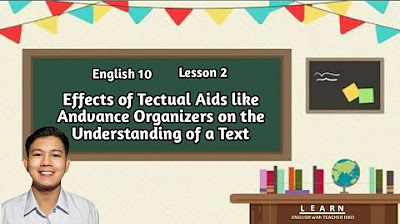TEXTUAL AIDS IN UNDERSTANDING TEXTS || Quarter 1 Week 2 || English 10 || MELC-BASED || Aizie Dumuk
Summary
TLDRIn this educational video, Teacher Izzy introduces various textual aids essential for interpreting and understanding texts. She emphasizes the importance of using visual aids like concept maps, flowcharts, and Venn diagrams to organize information. The lesson also covers the skill of transcoding between linear and non-linear texts, providing steps to convert textual information into accessible graphic organizers. Examples of textual aids such as pie charts, bar graphs, and timelines are discussed, enhancing students' ability to differentiate central ideas from details and understand cause-effect relationships.
Takeaways
- 📚 Textual aids are essential tools for interpreting and understanding texts, helping to present information in a more digestible format.
- 📊 Infographics, like bar graphs and Venn diagrams, simplify complex data, making it easier to read and interpret.
- 📖 The distinction between linear and non-linear texts lies in the reading path; linear texts are read from start to finish, while non-linear texts do not follow a sequential order.
- 🔄 Transcoding is a valuable skill that involves converting linear texts to non-linear formats and vice versa for better comprehension and presentation.
- 🧠 Key steps in transcoding include reading for the main idea, extracting necessary information, using keywords, classifying data, and presenting it correctly in a non-linear format.
- 🗺️ Concept maps, flowcharts, and Venns diagrams are examples of textual aids that organize information and show relationships between concepts.
- 📈 Graphic organizers like pie charts, bar graphs, and line graphs are used to visually represent data and differences between subjects.
- 📝 The main idea and details chart helps in distinguishing central ideas and their corresponding details from less important information.
- ⏳ Timeline charts are useful for visualizing events or developments that occur over time, aiding in understanding historical contexts.
- 💡 The video provides exercises to test understanding of different textual aids, reinforcing learning through practical application.
Q & A
What are the expected learning outcomes at the end of the lesson?
-The learners are expected to identify and differentiate the different types of textual aids, use various textual aids in interpreting and understanding texts, and present specific graphic organizers to represent content.
What is the main focus of the lesson?
-The main focus of the lesson is on various textual aids that can be used to assist in understanding texts, highlighting the importance and use of textual aids in presenting information.
What is the difference between linear and non-linear texts?
-Linear texts are traditional texts that require reading from beginning to end to make sense of the content, such as short stories and novels. Non-linear texts, on the other hand, do not require sequential reading and often include visual aids like concept maps, diagrams, and charts.
What are the steps to transcode a linear text into a non-linear text?
-The steps include: 1) Read the text and get the main idea, 2) Extract necessary information for visual presentation, 3) Use keywords or phrases only, 4) Classify information into categories, and 5) Use the correct non-linear text to present the information.
What is a concept map, and who typically uses it?
-A concept map is a diagram that depicts suggested relationships between concepts. It is commonly used by instructional designers, engineers, technical writers, and others to organize and structure knowledge.
How does a flowchart function, and where is it typically used?
-A flowchart is a graphical representation of steps in sequential order. It is widely used to present the flow of algorithms, workflows, or processes by showing steps as boxes connected by arrows.
What is the purpose of a Venn diagram, and how does it work?
-A Venn diagram illustrates the relationships among things using circles. Overlapping circles represent shared traits or commonalities, while non-overlapping circles represent differences. It visually displays similarities and differences between two or more concepts.
What is the purpose of a cause and effect diagram?
-A cause and effect diagram is used to logically organize possible causes for a specific problem or effect by graphically displaying them, suggesting causal relationships among theories.
What are the different types of graphs mentioned, and what is their general purpose?
-The types of graphs mentioned are pie charts, bar graphs, and line graphs. Their general purpose is to show differences between two or more subjects and represent data visually for easier interpretation.
What is a timeline chart, and what does it represent?
-A timeline chart is a visual rendition of a series of events that occurred over a period of time. It helps display chronological relationships between events or developments.
Outlines

This section is available to paid users only. Please upgrade to access this part.
Upgrade NowMindmap

This section is available to paid users only. Please upgrade to access this part.
Upgrade NowKeywords

This section is available to paid users only. Please upgrade to access this part.
Upgrade NowHighlights

This section is available to paid users only. Please upgrade to access this part.
Upgrade NowTranscripts

This section is available to paid users only. Please upgrade to access this part.
Upgrade NowBrowse More Related Video

HISTORICAL LITERARY APPROACH + EXAMPLE || QUARTER 3 WEEK 8 || MELC-Based || Aizie Dumuk

TEXTUAL AIDS || GRADE 10 || MELC-based VIDEO LESSON | QUARTER 1 | Module 2

Grade 10 English Q1 Ep4: Textual Aids

Textual Aids - English 10 - Lesson 2

English 10 | Quarter 1 | Week 2 Textual Aids in Understanding Text

EXPOSITION || QUARTER 2 WEEK 5 || ENGLISH 10 || MECL-BASED || Aizie Dumuk
5.0 / 5 (0 votes)